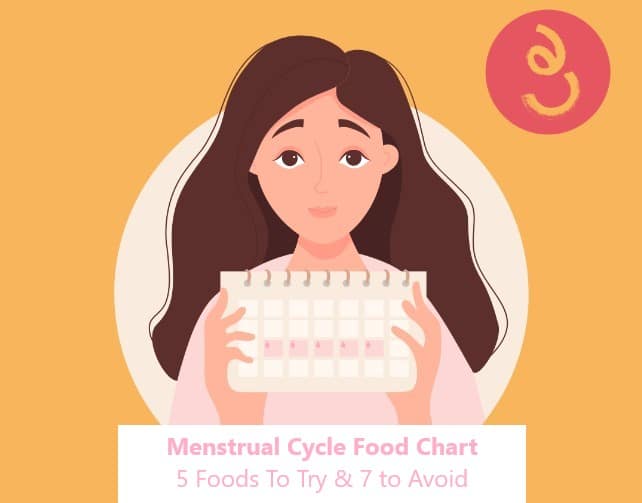Understanding what to eat and what to avoid during your menstrual cycle can help ease symptoms like cramps, bloating, mood swings, and fatigue. Cycle syncing—aligning your lifestyle and diet with the hormonal phases of your period—can improve your energy, productivity, and emotional well-being. In this guide, we’ll explore which foods support your body through each cycle phase and which ones may do more harm than good.
What Is Cycle Syncing and Why Does It Matter?
Cycle syncing is a holistic health strategy that involves adjusting your nutrition, exercise, and even social activities to match the four phases of your menstrual cycle. It’s rooted in the idea that your hormones affect not just your fertility, but your mood, energy, digestion, and sleep patterns too.
The Four Phases of the Menstrual Cycle
Understanding these stages helps you better support your body:
| Phase | Days | What Happens |
|---|---|---|
| Menstrual | Days 1–5 | Shedding of the uterine lining. Hormones at their lowest. Fatigue is common. |
| Follicular | Days 1–14 | Estrogen rises. Energy and mental clarity increase. |
| Ovulation | Around Day 14 | A mature egg is released. Hormones peak. Libido and confidence often rise. |
| Luteal | Days 15–28 | Progesterone increases. PMS symptoms like bloating and cravings may appear. |
👉 Jump to FAQs
👉 Explore our Perimenopause guide
Best Foods to Eat During Your Menstrual Cycle
Eating the right foods during your cycle can help balance hormones, reduce inflammation, ease cramps, and stabilize your mood. Here’s what to prioritize:
1. Water-Rich Fruits (Cucumber, Watermelon)
These hydrating fruits help reduce bloating and support digestion. They’re also naturally sweet, making them ideal alternatives to processed sugar. According to Healthline, staying hydrated with water-rich fruits can reduce water retention and alleviate period-related bloating.
Benefits:
-
Hydration
-
Curbs sugar cravings
-
Rich in antioxidants
2. Leafy Greens (Spinach, Kale)
Iron levels often drop during menstruation, especially with heavy bleeding. Leafy greens replenish iron and provide magnesium, which can reduce cramps and support mood. A WebMD article notes that iron deficiency is common during menstruation, and eating leafy greens can help counter this.
Tip: Cook greens lightly to preserve nutrients and aid digestion.
3. Yogurt (Probiotic-Rich Foods)
Hormonal fluctuations can disrupt gut flora, increasing the risk of yeast infections. Probiotic foods like yogurt help maintain a healthy vaginal microbiome. As per Healthline, probiotics can help balance bacteria, supporting digestive and vaginal health during your cycle.
Choose: Plain, unsweetened Greek yogurt over sugary options.
4. Dark Chocolate (70% Cocoa or Higher)
Dark chocolate is rich in magnesium, which may help reduce mood swings and cramps. It also satisfies chocolate cravings more healthfully than processed treats.
Caution: Even dark chocolate contains sugar and caffeine—consume in moderation.
5. Nuts and Seeds (Walnuts, Almonds, Flaxseeds)
Packed with omega-3s, healthy fats, and magnesium, nuts and seeds help manage inflammation and support hormone production. A study published in PubMed supports the role of dietary fats, particularly omega-3s, in alleviating menstrual symptoms such as cramps and irritability.
Bonus: Nut butters or nut milks are great alternatives if you don’t like raw nuts.
7 Foods to Avoid During Your Period
When you’re on your period, avoiding certain foods can significantly reduce symptoms like bloating, cramps, and mood swings. Here’s what to steer clear of:
1. Refined Sugars and Sweets
Sugary snacks can cause quick spikes in blood sugar, followed by crashes that worsen fatigue, irritability, and mood swings.
Better Option: Satisfy sweet cravings with dates, berries, or watermelon.
2. High-Sodium Foods (Salt-Rich Snacks & Processed Foods)
Too much salt causes your body to retain water, leading to bloating and puffiness.
Watch out for: Chips, canned soups, and processed meats.
3. Alcohol
Alcohol dehydrates your body, which can worsen headaches and cramps. It may also disrupt sleep and amplify digestive issues.
Symptoms Alcohol Can Exacerbate:
-
Nausea
-
Diarrhea
-
Fatigue
-
Headaches
-
Mood swings
4. Spicy Foods
Some women experience stomach discomfort or diarrhea from spicy meals, especially during menstruation when digestion is more sensitive.
Tip: Test your tolerance before eating anything extra spicy on your period.
5. Red Meat
Though it contains iron, red meat also increases prostaglandin production, which can intensify uterine contractions and menstrual cramps. Research summarized in Healthline notes that a high intake of animal fats can trigger more severe cramps due to prostaglandin overproduction.
Try instead: Iron-rich plant-based options like lentils, tofu, or cooked spinach.
6. Caffeine (Coffee, Energy Drinks)
Caffeine can contribute to bloating, dehydration, and breast tenderness. It can also interfere with sleep and worsen anxiety.
Tip: If you’re a regular coffee drinker, taper gradually to avoid withdrawal headaches.
7. Food Sensitivities or Intolerances
Avoid any foods you’re sensitive to (e.g., dairy, gluten) as they can worsen cramps and digestive symptoms during menstruation.
Example: If you’re lactose intolerant, skip the milkshakes—even if cravings are high.
Who Should Use This Menstrual Food Chart?
This guide is designed for:
✅ Women looking to naturally ease PMS and period symptoms
✅ Those interested in hormonal health and cycle syncing
✅ Athletes or professionals optimizing performance throughout their cycle
✅ Individuals with irregular cycles seeking better balance through nutrition
Additional Tips for Menstrual Wellness
-
Stay Hydrated: Aim for at least 8–10 glasses of water daily.
-
Don’t Skip Meals: Skipping food can make nausea, fatigue, and mood swings worse.
-
Choose Cooking Methods Wisely: Steaming or roasting helps retain nutrients better than deep-frying.
-
Consider Supplements: Iron or magnesium supplements may help, but consult your doctor first.
Frequently Asked Questions (FAQs)
Is cycle syncing with food really effective?
Yes. Although research is ongoing, many women report fewer cramps, more stable moods, and improved energy when they align nutrition with hormonal phases.
Is dark chocolate good during your period?
In moderation, yes. Dark chocolate is rich in magnesium and antioxidants, which may ease mood swings and cramps.
Can spicy food make your period worse?
For some women, yes. Spicy foods may irritate the stomach or cause diarrhea, particularly during the menstrual or luteal phases.
Should I cut out caffeine completely?
Not necessarily. If you consume caffeine daily, try reducing your intake gradually during your period rather than eliminating it abruptly to avoid headaches.
Is Bioma better than Provitalize for hormone balance?
Explore our full comparison of Bioma vs. Provitalize to see which is better for your goals—gut health or menopause support.
Final Verdict: Eat for Your Cycle, Not Against It
Supporting your body with the right foods during each menstrual phase is one of the simplest and most effective ways to manage period symptoms naturally. Whether you’re trying to reduce cramps, stay energized, or maintain mental clarity, nutrition plays a vital role.
Avoid trigger foods like sugar, caffeine, and alcohol, and focus on hydration, whole foods, and nutrient-dense options. Every cycle is different, and tuning into your body’s signals is the first step to better menstrual health.

